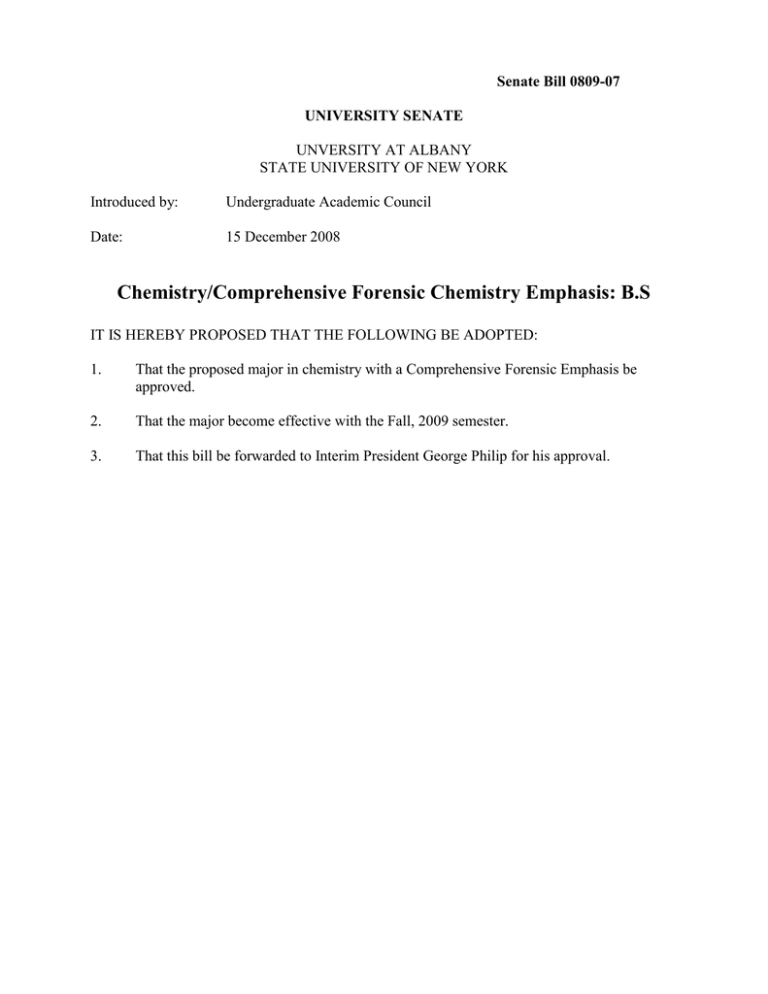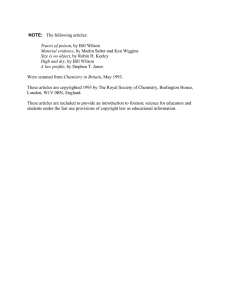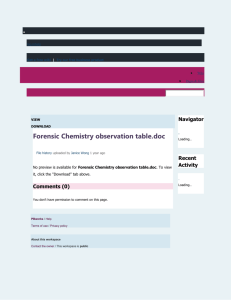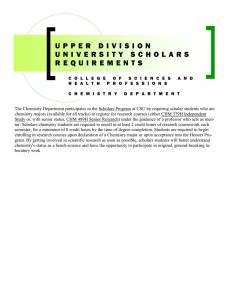Chemistry Major Forensic Emphasis
advertisement

Senate Bill 0809-07 UNIVERSITY SENATE UNVERSITY AT ALBANY STATE UNIVERSITY OF NEW YORK Introduced by: Undergraduate Academic Council Date: 15 December 2008 Chemistry/Comprehensive Forensic Chemistry Emphasis: B.S IT IS HEREBY PROPOSED THAT THE FOLLOWING BE ADOPTED: 1. That the proposed major in chemistry with a Comprehensive Forensic Emphasis be approved. 2. That the major become effective with the Fall, 2009 semester. 3. That this bill be forwarded to Interim President George Philip for his approval. Degree Requirements for the Major in Chemistry Chemistry/Comprehensive Forensic Chemistry Emphasis: B.S.: (combined major and minor sequence) (82 credits): A Chm 120 or 130, 121 or 131, 124, 125, 220, 221, 222, 223, 225, 350 or 444, 351 or 445, 352Z, 417, 420, 430, 442 or 342, 450 and 451; and A Mat 108, 111 or 112 or 118, 113 or 119, and 214; A Phy 140 or 141, 145, 150 or 151, 155; A Bio 110*; and nine (9) additional credits to be chosen from A Chm 425, A Chm 426, A Chm 455, R Crj 202, R Crj 310, R Crj 353, R Crj 404, R Crj 405. *Please note the Department of Biology is in the process of changing some of their course numbers. For this catalog copy of requirements, both the introductory lecture and lab are required (currently listed as A Bio 110). University at Albany – State University of New York College of Arts and Sciences Course Action Form Please mark all that apply: X New Course; new emphasis, see attached Revision of: Proposal No. Number Cross-Listing Title Shared-Resources Course Credits Deactivate / Activate Course (boldface & underline as appropriate) Department: Chemistry Course Number Course Title: X X 08-090 Description Prerequisites Other (specify): See below To be effective (semester/year): Spring 2009 Current: n/a New: n/a Credits: n/a n/a Course Description to appear in Bulletin: Other (specify): New emphasis, Comprehensive Forensic emphasis for B.S. Chemistry major. Prerequisites statement to be appended to description in Bulletin: n/a If S/U is to be designated as the only grading system in the course, check here: Please see attached This course is (will be) cross listed with (i.e., CAS ###): This course is (will be) a shared-resources course with (i.e., CAS ###): Explanation of proposal: Please see attached Other departments or schools which offer similar or related courses and which have certified that this proposal does not overlap their offering: Chair of Proposing Department (TYPE NAME/SIGN) Date 6/5/08 Approved by Chair(s) of Departments having cross-listed course(s) (PRINT NAME/SIGN) Albert Millis, BIO (see page 2) JoAnne Malatesta, CRJ (see pages 10-12) 5/21/08 Chair of Academic Programs Committee (PRINT NAME/SIGN) Date Date Dean of College (PRINT NAME/SIGN) Date Dean of Graduate (Undergraduate) Studies (PRINT NAME/SIGN) Date Department of Chemistry B.S .Chemistry Major – Comprehensive Forensics Emphasis Proposal: To provide students within the B.S. degree in Chemistry, a new forensic emphasis that is aligned with the requirements outlined by the American Academy of Forensic Scientists/Forensic Science Education Programs Accreditation Commission (AAFS/FEPAC). Proposed by: The University at Albany, Department of Chemistry Proposed first enrollment: January 2009 Rationale: Currently, the Department of Chemistry’s curriculum aligns with the curriculum required by the American Chemical Society (ACS). The current forensic emphasis curricula, and the new proposed emphasis, also meet the ACS criteria. However, the Department of Chemistry believes that having an emphasis that aligns with FEPAC accreditation would raise the stature of our program to the highest standard possible in the forensics community. With this shift in status, we anticipate enrollments would increase, and students graduating from this program would not only get jobs, but be in demand by forensics agencies because of their high level of competency. This accreditation would enhance our current collaborations with the New York State Police Forensics Investigation Center (NYSP FIC) as well as position us for broader collaborations and funding opportunities. Our Department anticipates that FEPAC accreditation will provide an external means to constantly evaluate, develop, and grow our program. In addition, in terms of admissions and enrollment, accreditation will help attract quality students and increase our students’ competency. FEPAC accreditation for science curricula is rare among academic institutions. The curriculum is demanding, but this rigor generates prestige and distinction in the field of forensics for both the academic institution and the graduates of the program. Currently, only seven (7) B.S. programs (Addendum A) in the nation are both accredited by FEPAC in forensic chemistry and align with the ACS standards. If we were to take the initiative to acquire FEPAC accreditation for our new emphasis, the University at Albany would have the unique position of being the only FEPAC accredited chemistry program that also meets ACS criteria in the northeast. For our program to meet the FEPAC academic accreditation standards, all coursework is already in existence at the University at Albany, and NO new coursework would need to be developed. Our feedback from the forensic science community is that, first and foremost, our department’s curriculum must be designed to foster chemists, as forensic scientists are first and foremost analytical chemists, who apply their chemical knowledge and abilities to the field of forensic science. Indeed, the attribute most lacking in recent forensic chemistry graduates is cited as a fundamental grasp of the core principles of chemistry, and in this spirit, we believe strongly in maintaining our standard ACS curriculum. Background: Our current B. S. degree in Chemistry with a forensic emphasis just finished its third academic cycle, with enrollment data in the ACHM 450/550A Forensic Chemistry course showing a year-to year increase that parallels the high level of student interest in this track. The actual enrollment numbers for the two semester, grad/undergrad course are as follows: Department of Chemistry Forensic Chemistry Course Enrollment Term BS MS Fall 2005- Spring 2006 6 Fall 2006 – Spring 2007 9 2 Fall 2007 – Spring 2008 11 2 Fall 2008 10 4 Spring 2008 total Chemistry majors Spring 2008 total Chemistry forensics majors 93 33 In the 2007-08 academic cycle, we initiated our first internships in forensic chemistry, with two students joining the New York State Police Forensics Investigation Center as interns. These internships were unqualified successes. Feedback from the FIC regarding these interns has been extremely positive reinforced by the fact that our undergraduate intern was hired full-time at the FIC, prior to graduation, and finished her final semester for her degree while working full-time. We currently have our third and fourth interns now gaining valuable experience at the FIC. Based on our discussions with the NYSP FIC, similar internships, approximately two per semester, will be available for our students. At issue: We are submitting this proposal through University Governance because, by creating a new forensics emphasis to meet FEPAC requirements, we will be developing an emphasis requiring 82 credits. This credit requirement is inordinately high and must receive University at Albany approval prior to implementation. Program Description: Below is a comparison of our Chemistry B.S. degree (forensic emphasis) with the proposed Comprehensive forensics emphasis: Current B.S. degree Forensic emphasis New Comprehensive B.S. degree Forensic emphasis General Chem (8 total) Chm 120 or 130 (3) Chm 124 (1) Chm 121 or 131 (3) Chm 125 (1) General Chem (8 total) Chm 120 or 130 (3) Chm 124 (1) Chm 121 or 131 (3) Chm 125 (1) Organic Chem (8 total) Chm 220 (3) Chm 222 (1) Chm 221 (3) Chm 223 (1) Organic Chem (8 total) Chm 220 (3) Chm 222 (1) Chm 221 (3) Chm 223 (1) Physics (8 total) Phy 140 Phy 145 Phy 150 Phy 155 Physics (8 total) Phy 140 Phy 145 Phy 150 Phy 155 (3) (1) (3) (1) (3) (1) (3) (1) FEPAC requires (1) course in diff./integral calc. and (1) course in statistics – (6) total Math (7 total) Math (7 total) Mat 112 Mat 108-statistics (4) (3) Mat 112 Mat 108-statistics (4) (3) FEPAC requirements (12) credit hours specialized coursework, including (2) labs Specialty Courses (13 total) Specialty Courses (13 total) Chm 225 Mat 113 Chm 420 Chm 430 (3)lab (4) (3) (3)lab Chm 225 Mat 113 Chm 420 Chm 430 (3)lab (4) (3) (3)lab FEPAC requirements (19) credit hours in advanced courses Advanced courses (19 total) total) Advanced Courses (19 Mat 214 Chm 442 (or 342) Chm 350 (or 444) Chm 351 (or 445) Chm 352Z Chm 417 Mat 214 (4) Chm 442(or 342) (3) Chm 350 (or 444) (3) Chm 351 (or 445) (3) Chm 352Z (3) Chm 417 (3) (4) (3) (3) (3) (3) (3) Forensic courses (6) Chm 450 Forensic (3) Chm 451 Forensic (3) 69 credits total FEPAC rqmt (15) cr. in forensics Chm 450 Forensic (3) Chm 451 Forensic (3) Forensic electives *see below (9) Bio 110 Gen Bio I (4) 82 credits total Additional Forensic Chemistry elective options (9 credits) Chm 425 Chemistry Research Chm 455 Forensic Internship Crj 202 Introduction to Law and Criminal Justice Crj 310 Policies of Crime in Heterogeneous Societies Crj 353 American Criminal Courts Crj 404 Crime and the Mass Media (Prereq. Crj 202) Crj 405 Drugs, Crime and Criminal Justice (Prereq. Crj 202) (up to 6 credits) (up to 6 credits) (4) (3) (3) (3) (3) Major Academic Pathway: A Major Academic Pathway draft, outlining the curriculum to be undertaken by our students, is included in Addendum B. Evidence for Demand: When the concept for the current forensics emphasis for our chemistry major was considered, it was in response to demand by the forensics community for forensic scientists with an educational foundation in chemistry. Specifically, the New York State Police Forensics administrators felt so strongly about the demand that they partnered with the University to develop and outline the curriculum for this emphasis. In the Northeast region alone, thirty-two crime laboratories are accredited by American Society of Crime Laboratory Directors & the Laboratory Accreditation Board. The 32 accredited laboratories include state, local agency, federal, and private laboratories. With the FEPAC credential, we could become the feeder institution to supply many of these central agencies with appropriately trained forensic chemists. In addition, with the high degree of proficiency required to perform forensic techniques, private laboratories would also find our graduates desirable candidates for employment. Costs and Resources: All courses are offered currently. No increase in instructional resources is required. Impact on Current Programs: The Department of Chemistry B.S. program: Forensic Chemistry majors now account for 35% of our majors. As interest in this program grows, we expect the same will happen with our enrollment. Other University programs: Other programs affected by our proposed new emphasis include Criminal Justice and Biology, as students in this proposed track would be taking courses from these programs. Accordingly, letters of support from both the Department of Criminal Justice and the Department of Biological Sciences are in Addendum C. The New York State Police: A letter of support from this collaborating organization in the form of a Memorandum of Understanding is attached. Please see Addendum D. Resolution: While we acknowledge that the current FEPAC credit requirement could be challenging for our students, we would like to include additional metrics in support of our proposal. First, the proposed FEPAC accredited curriculum is designed intentionally to meet ACS certification standards, and is also designed to be modular. Should a student pursuing the forensic degree emphasis decide to reconsider their academic path, they have the option to fall back into the ACS accredited B.S. in chemistry with no penalty. Second, our faculty administered a poll to our 11 B.S. graduates from 2008 who took the Spring ACHM 451 Forensic Chemistry course. The students were asked their preference for taking the current 69 credit program as opposed to the new emphasis that aligns with FEPAC accreditation. The survey yielded 10-1 in favor of the FEPAC curriculum (and incidentally, the one student opposed has applied to the M.S. forensic chemistry track here at the University at Albany). Upon further questioning, the students felt the application of the science to an occupation and career path was extremely desirable and attractive to them: to summarize, they wanted more forensics-related coursework. The major component necessary for FEPAC accreditation that is lacking in our science-intensive curriculum is a focus on the legal aspects of forensic science, including law and courtroom testimony. In collaboration with our nationally recognized Department of Criminal Justice here at the University at Albany, we intend to include coursework in criminal justice that satisfies the remaining FEPAC accreditation standards. The Assistant Dean of the Criminal Justice Department, Dr. Joanne Malatesta, has provided a letter of support in this endeavor, specifically stating that seats will be reserved for our students in the forensic emphasis track. Both the B.S. and M.S. programs in Forensic Chemistry and the M.S. in Forensic Molecular Biology (currently approved for a full 5-year accreditation from FEPAC) were developed under the auspices of a $1.5 million Department of Justice grant. Our programs have benefited immensely from said grant, helping our department renovate and equip a forensic laboratory that mirrors the FIC laboratories. Our forensic laboratory is one of the best equipped in the nation, and is an enormous asset to the program and our department. One final point, the Chemistry Department would like to note, that for the first time, we have received applications to our M.S. forensic program from applicants who attend other FEPAC accredited universities, and feel that is an indication of our program’s increased visibility. Future Developments: The Department of Chemistry also expects to apply for FEPAC accreditation for its M.S. degree in Forensic Chemistry Summary: The accredited B.S. degree program with a forensic emphasis is of mutual benefit to all parties concerned. The students are served by participation in a program that stimulates their desire for knowledge, while providing undergraduate internship opportunities for which they can receive academic credit, which positions them on an exciting career path. The University gains prestige and greater exposure from accreditation, along with increased student interest and enrollment. The NYSP FIC gets a local pool of applicants to draw from, for both internships and full-time employment, and will experience gains in reputation for its association with an accredited program. The Chemistry Department enjoys increased enrollment and student enthusiasm, as well as the distinction that will come with accreditation. Addendum A FEPAC ACCREDITED B.S. Chemistry/Forensics Cedar Crest College, Allentown, PA: Full Accreditation (5-year term) for the B.S. Degree in Chemistry, Biochemistry, and Biology with a concentration in Forensic Science (01/2010). Florida International University, Miami, FL: Full Accreditation (5-year term) for the Certificate Programs with the B.S. Degree in chemistry or biology (01/2009). Metropolitan State College of Denver, Denver, CO: Full Accreditation (5-year term) for the B.S. Degree Program in Chemistry with a concentration in Criminalistics (01/2009). University of Mississippi, University, MS: Full Accreditation (5-year term) for the B.S. Degree in Forensic Chemistry (01/2012). Ohio University, Athens, OH: Full Accreditation (5-year term) for the Bachelor of Science in Forensic Chemistry Program (01/2012). West Virginia University, Morgantown, WV: Full Accreditation (5-year term) for the B.S. Degree - Forensic and Investigative Science Program (01/2010) University of North Texas, Denton, TX: Conditional Accreditation (one year) for the Certificate Programs in Conjunction with the Bachelor of Science in Biochemistry, Biology, and Chemistry (01/2008 - 01-2009) Addendum B Major Academic Pathway (MAP) Chemistry, Forensic Chemistry Emphasis Bachelor of Science Fall Semester 1 (15 cr.) AChm 120/130 AChm 124 (lab) APhy 140/141 APhy 145 (lab) AMat 112/118 Humanities NS NS MS HU Fall Semester 2 (15 cr.) AChm 220 & 222 (lab) AMat 214 Bio 110 CrJ 202 Fall Semester 3 (15 cr.) AChm 350 AChm 352Z Global & Cross-Cultural Foreign Language 1 Social Science Gen Ed Fall Semester 4 (15 cr.) AChm 450 AChm 442 AChm 420 US Historical Perspectives Oral discourse Gen Ed Spring Semester 1 (15 cr.) AChm 121/131 AChm 125 (lab) APhy 150/151 APhy 155 (lab) AMat 113/119 Art AR Spring Semester 2 (14 cr.) Chm 221 & 223 (lab) Chm 225 Mat 108 Lower level writing LL WI UUnl 205 or 206 (1 cr.) IL Spring Semester 3 (15 cr.) AChm 351 ULWI AChm 430 GC Regions Beyond Europe BE Foreign Language 2 FL SS Social Science SS US OD Spring Semester 4 (16 cr.) AChm 451 ACHM 417 Europe EU Diversity and Pluralism DP Electives AChm 199 (1 cr.) Summer 1 Consider coursework Look for summer job in chemistry Summer 2 Consider study abroad options or research opportunities Summer 3 Summer internship or research Advanced forensic elective options CrJ 310 (DP) CrJ 353, 404, 405 Forensic internship Chemistry research General Education Requirements Disciplinary Perspectives Communication and Reasoning Competencies AR Arts (min. 3 crs.) IL Information Literacy (min. 1 course) HU Humanities (min. 3 crs.) OD Oral Discourse (min 1 course) NS Natural Sciences (min. 6 crs.) WI Written Discourse: SS Social Sciences (min. 6 crs.) --LL Lower-level writing (min 1 course) Cultural and Historical Perspectives --UL Upper-level writing (min 1 course) US U.S. Historical Perspectives (min. 3 crs.) MS Mathematics and Statistics (one semester of EU Europe (min. 3 crs.) collegiate study, or the equivalent, of math BE Regions beyond Europe (min. 3 crs.) at or above the level of pre- calculus GC Global & Cross-Cultural Studies (min. 3 crs.) and/or probability, stats and data analysis DP U.S. Diversity and Pluralism (min. 3 crs.) FL Foreign Language (two semesters of collegiate study, or the equivalent, of **Courses selected in the major, minor or as a foreign language electives may also satisfy General Education requirements Addendum C Addendum D


